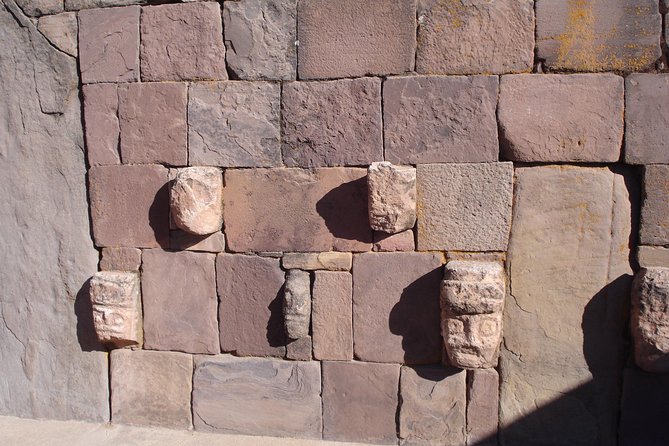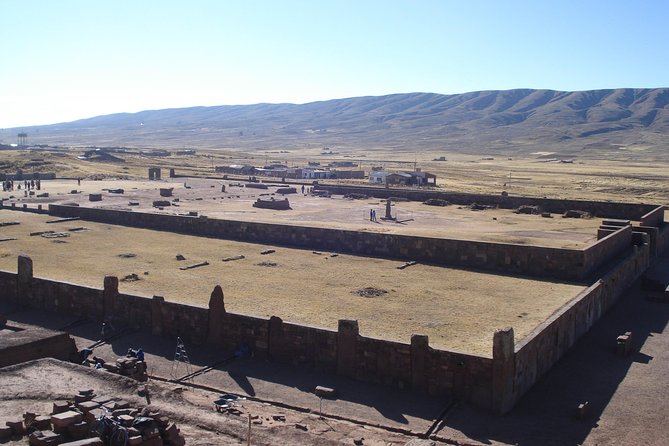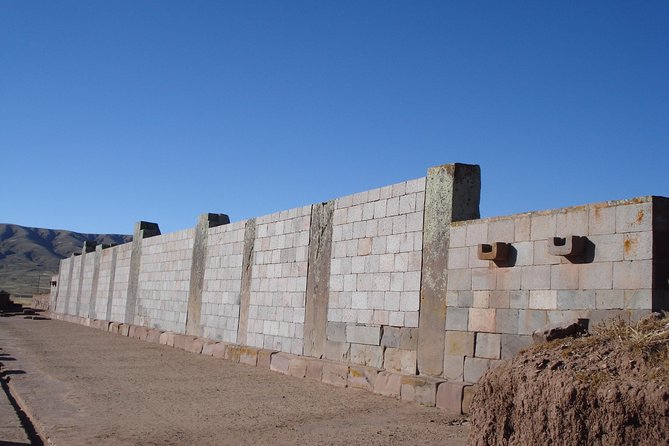Tiwanaku, known as the Cradle of Andean Civilizations, thrived between 300 and 1000 AD, leaving an indelible mark on the region’s history. Its monumental structures, like the Akapana Pyramid and the enigmatic Gateway of the Sun, reveal a society rich in architectural prowess and spiritual depth. As a hub of trade and agricultural innovation, Tiwanaku not only shaped its own destiny but also set the stage for future empires, including the formidable Inca. Yet, beneath its impressive façade lies a complex narrative waiting to be uncovered. What secrets might this ancient site still hold?
Good To Know

- Tiwanaku flourished between 300 and 1000 AD, serving as a vital political, cultural, and religious center in the Andean region.
- The site is renowned for its advanced engineering, with monumental structures like the Akapana Pyramid and Gateway of the Sun showcasing architectural brilliance.
- Tiwanaku influenced surrounding regions through trade and agricultural innovations, laying the groundwork for later empires, including the Inca.
- Rich cultural heritage is reflected in intricate stone carvings, ceremonial artifacts, and monoliths that demonstrate the civilization’s understanding of astronomy and agriculture.
- As a UNESCO World Heritage Site, Tiwanaku offers visitors breathtaking views, accessible pathways, and a unique insight into Andean civilization.
Historical Significance of Tiwanaku

Why has Tiwanaku become a cornerstone in the study of Andean civilizations? Its historical significance lies in its role as a political, cultural, and religious hub.
Flourishing between 300 and 1000 AD, Tiwanaku was a melting pot of diverse cultures, influencing surrounding regions through trade and agricultural innovations. Scholars recognize it as a precursor to later empires, including the Inca.
The site’s extensive ruins reveal advanced engineering and urban planning, showcasing a society that thrived in challenging high-altitude environments. Its monumental structures, like the Akapana Pyramid and the Semi-Subterranean Temple, reflect both spiritual beliefs and social organization.
Tiwanaku’s enduring legacy continues to captivate historians, offering profound insights into the complexities of Andean civilization development.
Find more activities and experiences we've covered in Copacabana.
Architectural Marvels

Tiwanaku boasts an array of architectural marvels that showcase the ingenuity and sophistication of its ancient builders, with structures like the Akapana Pyramid and the Semi-Subterranean Temple exemplifying their advanced design and engineering skills.
The Akapana Pyramid, a terraced structure rising majestically, reflects the civilization’s astronomical alignments and religious significance.
Meanwhile, the Semi-Subterranean Temple, with its intricately carved stone blocks and unique layout, reveals their mastery in craftsmanship and urban planning.
Plus, the Gateway of the Sun stands as a monumental entryway, adorned with enigmatic carvings that hint at the cultural beliefs of the time.
Collectively, these structures not only captivate visitors but also serve as a testament to the remarkable capabilities of Tiwanaku’s ancient architects.
Cultural Heritage and Artifacts
Rich in history, the cultural heritage and artifacts of Tiwanaku reveal the profound beliefs, social structures, and artistic expressions of its ancient civilization.
Intricate stone carvings, like the famous Gate of the Sun, showcase remarkable craftsmanship and celestial significance. The ceremonial objects, such as pottery and textiles, reflect the spiritual life and daily activities of the Tiwanaku people.
Plus, the fascinating monoliths, often adorned with symbolic motifs, serve as a testament to their advanced understanding of astronomy and agriculture. These artifacts not only provide insights into their societal hierarchy but also illustrate the deep connection between the environment and their cultural practices.
Collectively, they paint a vivid picture of a civilization that thrived in harmony with nature and community.
Visiting Tiwanaku: What to Expect
Visitors can enjoy the ancient wonders of this UNESCO World Heritage Site, where monumental architecture and intriguing history await exploration. The site boasts impressive structures like the Akapana Pyramid and the Gate of the Sun, each telling stories of the Tiwanaku civilization.
As they wander through the expansive grounds, guests will encounter intricately carved stone sculptures and ceremonial altars that reflect the culture’s rich spirituality. The high-altitude setting offers breathtaking views of the Andes, enhancing the experience.
With accessible pathways and knowledgeable guides fluent in English and Spanish, travelers of all backgrounds can enjoy a seamless visit. Lunch is often included, allowing guests to savor local flavors while soaking in the captivating ambiance of this ancient site.
Guided Tours and Pricing
Guided tours of this ancient site offer an enriching experience, combining expert knowledge with the convenience of private transportation and inclusive pricing that caters to various group sizes.
Operated by David Paco Hannover, these tours start from $116.10, ensuring affordability for everyone. Each tour includes entrance fees, a bilingual guide fluent in English and Spanish, and a delicious lunch, complete with a refreshing soda.
Guests appreciate the hassle-free pickup from their hotels, with specific details confirmed upon booking.
With a commitment to customer satisfaction, the tour provider guarantees the lowest price and free cancellation up to 24 hours before the experience starts.
This thoughtful approach makes exploring the wonders of Tiwanaku accessible and enjoyable for all visitors.
Accessibility Features

Tiwanaku is designed to be accessible for everyone, featuring wheelchair and stroller-friendly pathways that ensure a comfortable exploration of this ancient site.
Visitors can easily navigate the expansive grounds, allowing them to appreciate the remarkable stone structures and intricate carvings without barriers. The site is well-equipped with ramps and smooth surfaces, making it convenient for those with mobility challenges.
Plus, Tiwanaku’s proximity to public transportation enhances accessibility, inviting a diverse range of travelers to experience its rich history.
With most travelers able to participate, the site prioritizes inclusivity, ensuring that everyone can explore the wonders of the Andean civilization without limitations, fostering a shared appreciation for this extraordinary cultural heritage.
Local Cuisine and Dining Options
Exploring the local cuisine around Tiwanaku offers a delightful opportunity to savor traditional Bolivian flavors that reflect the rich cultural heritage of the Andean region. Visitors can indulge in a variety of dishes that showcase local ingredients and cooking techniques.
Here are four must-try items:
Salteñas – A savory pastry filled with meat, potatoes, and spices, perfect for a snack.
Sopa de Maní – A hearty peanut soup that warms the soul, often served with beef and vegetables.
Pachamanca – A traditional Andean dish cooked in an underground oven, featuring marinated meats and root vegetables.
Api – A warm, sweet beverage made from corn and spices, enjoyed as a breakfast staple.
These culinary delights truly enhance the Tiwanaku experience, connecting visitors to its vibrant culture.
Tips for a Memorable Visit
To make the most of a visit to this ancient site, travelers should enjoy the rich history and stunning architecture that surrounds them.
They can start their journey with a guided tour, ensuring they don’t miss any key details about Tiwanaku’s fascinating past.
Comfortable footwear is essential, as exploring the site involves walking over uneven terrain.
Visitors should also bring sunscreen and water to stay hydrated and protected from the sun.
A camera is a must, as the breathtaking views and intricate stonework are unforgettable.
Lastly, indulging in local cuisine at nearby eateries can enhance the experience, allowing travelers to savor traditional flavors while reflecting on their visit to this remarkable cultural landmark.
Frequently Asked Questions
What Are the Best Months to Visit Tiwanaku?
The best months to visit Tiwanaku are May to September. During this period, travelers enjoy pleasant weather, less rainfall, and clear skies, making exploration of the ancient site more enjoyable and memorable for all visitors.
Is There an Age Restriction for Visiting Tiwanaku?
There isn’t an age restriction for visiting Tiwanaku. Families with children and seniors can enjoy the experience together. The site’s accessibility features ensure everyone can participate and appreciate its rich historical significance.
Are There Restroom Facilities at the Site?
Visitors will find restroom facilities conveniently located at the site, ensuring comfort during their exploration. The amenities make it easy for everyone to enjoy their experience without worrying about basic needs while discovering the rich surroundings.
Can I Take Photographs at Tiwanaku?
Visitors can take photographs at the site, capturing its stunning architecture and rich history. David ensures guests feel free to document their experience, making memories that last long after the tour ends.
What Should I Wear When Visiting Tiwanaku?
When visiting, he suggests wearing comfortable shoes for walking, layering clothes for changing weather, and bringing a hat or sunscreen for sun protection. Staying prepared ensures an enjoyable experience while exploring this fascinating destination.
The Sum Up
To sum it up, Tiwanaku’s rich history and breathtaking architecture offer a glimpse into the ingenuity of ancient Andean civilizations.
Visitors are captivated by its monumental structures and cultural artifacts, which echo the spiritual and political significance of this remarkable site.
By exploring Tiwanaku, one not only appreciates its past but also the enduring legacy that shaped future empires.
A journey to this UNESCO World Heritage Site promises an unforgettable experience, blending history, culture, and natural beauty in perfect harmony.
